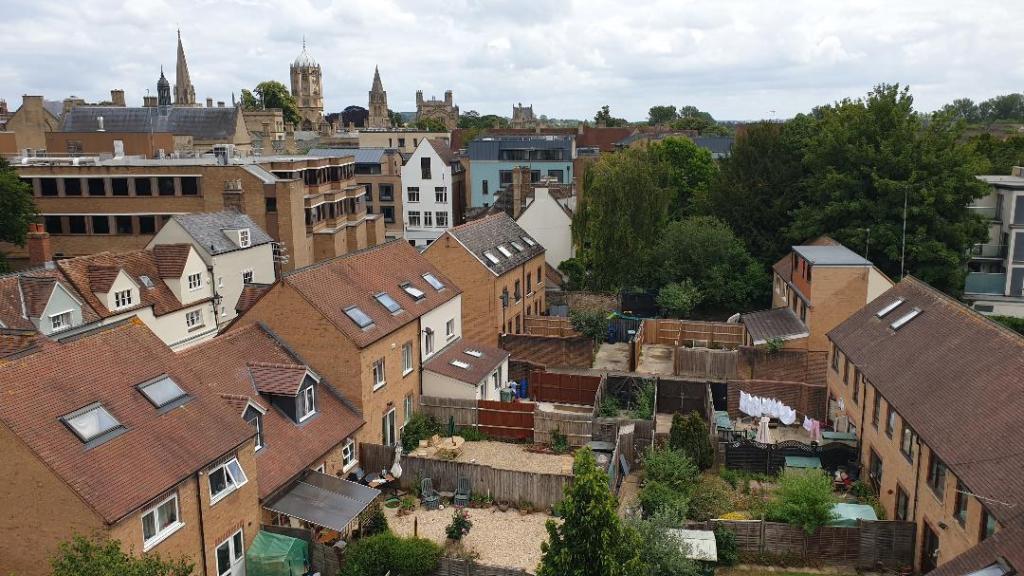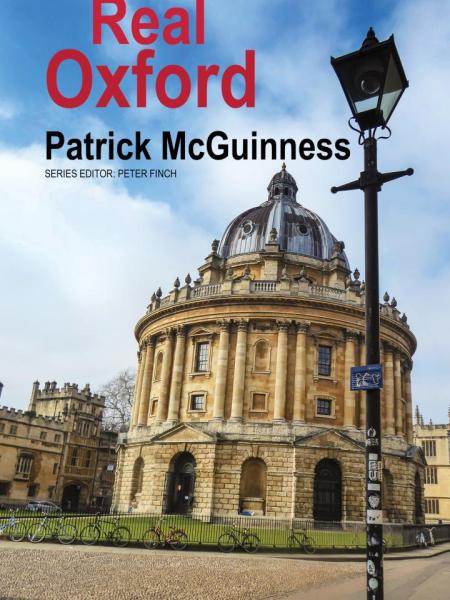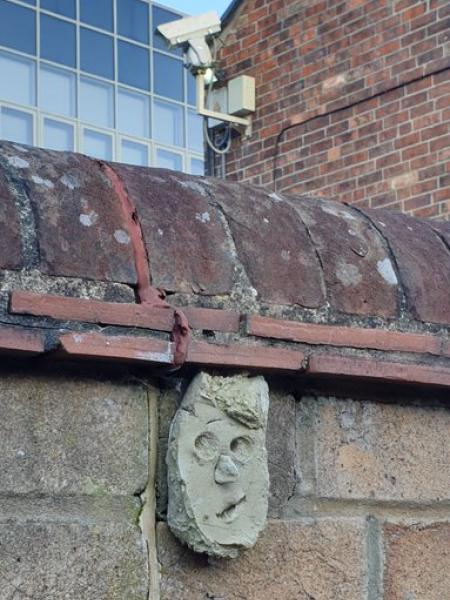
Where the medieval West Gate of the city stood is the Westgate shopping centre. It's the second incarnation of its kind. The front has a row of pigeonproof spikes where the pigeons perch undeterred. The old Westgate was dreary and ailing, the new one is dreary and buzzing. It’s designed to be open to the elements. Apparently it gives the place a bright open-air feel. I know that it’s to speed up the footfall, make it harder to dawdle, and discourage homeless people from sheltering. There’s no seating. It's criss-crossed with little alleys and roads that have olde worlde names and replicate, in a parody of commemoration, the small streets that were bulldozed to make way for it: Trill Mill Lane, Bridge Street, Leiden Square. The latter was opened to celebrate Oxford’s longest-standing city twinning, dating from 1946. Staying with the theme of European reconciliation, Bonn Square is opposite the Westgate entrance, where Jehovah’s Witnesses preach and the drinkers drink, laugh, argue and fight slowly around benches. The busking is poignant, occasionally desperate. Oxford is a polarised city, and it’s no surprise that the street music is also: it’s either students, schoolchild prodigies and amazing gypsy accordionists, or hopeless one-chord tunesters with toy mikes and Bontempi keyboards.

The Westgate is designed to kill the flâneur’s spirit, so I tell myself to pass by and ignore it. But that’s a cop-out. The prince of flâneurs, Baudelaire, would take this place as a challenge. He’d come at an angle not just to the traffic but to the ethos of the place, arriving around 5.30, one drink in, maybe two – just enough to put an ironic glaze on things, to see the place in inverted commas. The shopping crowds would be thinning. Artificial light would be starting to replace natural light – a change, as he knew, in more than just lighting. The 'cité sans soir' (as Mallarmé called it) is moving into a new phase, and us with it. There’d be a different clientele now – post-work drinks types heading for the bars and eateries on the top floor, or the multiscreen cinema. The man of the crowd would be changing direction, switching current, shorting the urban circuits. Baudelaire – or as my students call him, 'Charlie B' – would hang about on the edges of the Westgate, where the bins loiter and the deliveries come and go. He’d be drawn to the numbered bus-stops near the few remaining houses of St Ebbe’s that lie amputated and outscaled. On Trill Mill Lane in the Westgate there’s a panel inviting us to ‘Find out more about the vanished suburb of St Ebbe’s’. The West Gate of Oxford was full of businesses, artisanships and small industries. In that sense the shopping centre is still doing the work of its medieval and renaissance antecedents, as well as its 18th and 19th century predecessors. The old St Ebbe's was an architectural calque: some buildings were ancient, some were 17th and 18th C, some were Victorian terraces. It's still just about possible to see the different strata. From the 20s and 30s onwards, its days were numbered. St Ebbe’s is mentioned as a problem area by successive planners, not just the flouncing aesthetes and the dead-eyed pragmatists, but the Victorian social reformers and the inter-war progressives who designed new council housing for Oxford's growing industrial population. The term 'social cleansing' didn’t exist then, but the practice was being fine-tuned in the mandarin minds of planners. It was eventually carried out in the 1960s, the populations rehoused on the outskirts of Oxford – Barton, Rose Hill, Blackbird Leys.
So this should temper my nostalgia. But I can't help imagining St Ebbe's preserved. Today it might be a larger and more beautiful place than Jericho: mixed city-centre housing with an eco-system of local businesses, a market, bakeries and shops (probably quite chichi by now, more sourdough than Mother's Pride), with its own riverbank and bridges, at the heart of a connected city. It could even have been the connection itself, as it once was.
In corporate info-panel parlance, St Ebbe's vanished.
I’d take Baudelaire up the escalator to where the cocktail lounges are and show him, down below, the gardens of the houses that are left from the flattening of St Ebbe’s, once Oxford's working-class city centre. A few parked cars, some rusting barbecues in the garden, a trampoline. A tiny row of 17th C houses and their 1970s successors. Live branches on the trunk of a dead tree. One of gardens has a pole and flies a ragged England flag. Baudelaire would write a prose poem about life in the interstices of capitalism and set it right here, then head downstairs to poke about among these strange last-street-standing bits of Oxford. They feel pickled: that is to say, preserved like body parts. I’d leave Baudelaire to it, because I’d be heading to UNIQLO, where I buy my shirts. What I resent most about the Westgate is that I shop there. But Baudelaire knows that too: as we're double-bluffing, he's already on the triple-bluff, ironising his way back to sincerity.
The old Sainsbury’s has held on, and half of it is in the shopping centre, the other half opens out onto a scrappy humdrum square with a dead pub – another place whose customers now live too far away. There’s the ubiquitous planning permission notice in the cracked window. I don’t need to read it to know it’s more flats. Last summer I was in the Sainsbury’s for the first time in a decade and witnessed a superbly-choreographed piece of shoplifting. It was hot and the disposable barbecues were stacked up at the door. One man ostentatiously swiped one, setting off the alarms, and when the store detective gave lumbering chase, another, already inside, ran out with a bag of steaks and a bottle of red wine, grabbing another barbecue for good measure. All that was missing was the salad. It was as if Baudelaire had sold the film-rights to an unpublished prose poem. The disposable BBQ is a staple of summer in Oxford, and the area around the Westgate – St Ebbe’s, Paradise Square, etc – has various shelters for homeless people and assisted living. Baudelaire would have written about that. I teach Baudelaire a lot, but I’ve yet to take students on a Baudelaire field trip here. If I called it that I might get my college to pay for it.

My experience of purpose-built shopping centres is that they’re the first thing in a town to go out of date. They go from spanking new to used-up without any of the intermediary benefits of ageing: that weathered look, a durable aura, a sense of absorbing time rather than dissolving in it. Nor can anyone recall exactly when the transition took place. It’s because every shopping centre is the result of money imagining a future. The more money there is, the less future it can imagine. So they knock down houses and buildings that have stood 300 years and replace them with structures that are lucky to last 30. If you don’t believe me, take a look at the Clarendon Centre, a few yards away on Cornmarket. Half the shops there are closed or pop-up, low-rent junk-mongerers selling vape liquid or wrapping paper. Even the security guard there is part-time. She’s Albanian, and today I have my bike, which is not allowed, so she shoos me out, pointing at the sign saying ‘No Bikes, No Smoking’ etc. I know her from the number 3 bus – Rose Hill to the City Centre. She orders me not to make her laugh because she’s just had dental work and it hurts. Someone sells pale sweets from boxes on a trestle table. Another sells phone cases and half-price calendars for a year half-gone.
That’s the Clarendon Shopping Centre: where the future came, took a look around, and went somewhere else.